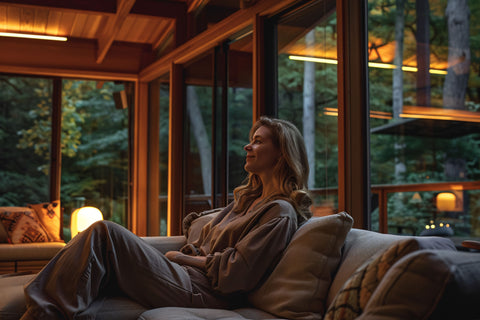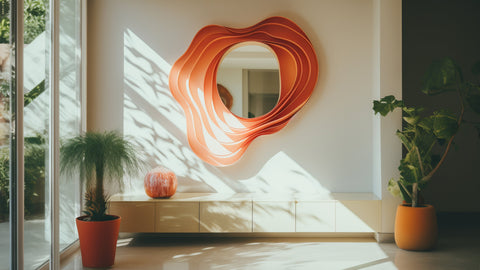There are lights that dazzle, and then there is light that seduces quietly—the kind that never shines directly, but gently wraps a space in elegance, subtlety, and depth. This is indirect lighting, a refined solution increasingly embraced in contemporary interior design for its ability to create intimate and calming atmospheres, where every detail is enhanced without being overwhelming.
Indirect light meaning and benefits
To understand what does indirect light mean, you need to imagine a light source that, instead of projecting light directly onto objects or people, reflects it onto walls, ceilings, or other architectural elements, which then softly and evenly diffuse the light throughout the space.
This type of indirect lighting not only drastically reduces harsh shadows and strong contrasts but also helps improve the perception of space, making it visually larger and more harmonious. In practice, it creates an ambient light that envelops the room without ever becoming the main focus.
Direct and Indirect Lighting: What’s the Difference?

When comparing direct and indirect lighting, the distinction lies in direction and intensity. Direct lighting comes from sources that shine directly on a surface or task—like a reading lamp or a kitchen spotlight. Indirect lighting, by contrast, bounces off reflective surfaces to create a softer, more diffused effect.
This difference also impacts visual comfort. Indirect light is gentler on the eyes and reduces fatigue, especially in spaces where you spend long hours or aim to create a relaxed mood. While direct lighting is practical for task-oriented zones, indirect lighting is designed more to accompany moments than to illuminate with precision.
What Fixtures Provide Indirect Lighting?

If you want to light a room indirectly, here are the most common tools and techniques:
-
Recessed LED strips, often installed in false ceilings or inside architectural niches, ideal for creating soft, architectural indirect lighting.
-
Wall sconces or wall washers that project light upward or downward, using the wall as a reflective surface.
-
Floor lamps with upward-facing shades, which illuminate the ceiling and amplify the sense of space.
-
Track or pendant systems designed to aim light toward architectural features rather than directly onto furniture.
-
Natural light, filtered through windows and reflected off light-colored walls, contributes to soft, ambient illumination.
-
Wall paint: choosing light colors for the walls allows them to become reflective surfaces, enhancing the diffusion of light throughout the space.
The key is always the same: the light source must be shielded or directed so that it does not hit the eye directly, but rather blends seamlessly with the environment.
Indirect Lighting in the Kitchen
When thinking about how to use indirect lighting in the kitchen, the goal is to balance style with function. While direct light remains essential over work areas like countertops, integrating indirect light can completely transform the space’s mood.
One effective approach is installing LED strips above cabinets to reflect light onto the ceiling, or behind a breakfast bar to create a subtle yet scenic effect. The result? A more welcoming kitchen that radiates cleanliness, order, and modern elegance.
Indirect Lighting in the Living Room
The living room is where indirect lighting shines—literally and figuratively. Its versatility allows for a range of atmospheres. A false ceiling with perimeter LED strips can adjust the mood throughout the day, while an upward-facing floor lamp provides soft, even illumination—ideal for conversation or movie nights.
Additionally, highlighting paintings, bookshelves, or wall textures with indirect lighting creates depth and visual interest without the risk of unpleasant shadows or glare spots.
Indirect Lighting in the Bathroom
In the bathroom, where lighting must combine practicality and aesthetics, indirect lighting is an increasingly appreciated solution. Placed behind the mirror or along the perimeter of the room, it allows for indirect illumination without creating annoying reflections.
This type of light, reflecting off ceramic or glass surfaces, provides a greater sense of spaciousness and visual cleanliness. Additionally, it helps create an environment similar to a home spa, where light plays a key role in promoting relaxation.
5 Reasons to Use Indirect Lighting

-
Superior visual comfort: indirect light reduces harsh shadows and glare, making it easier on the eyes.
-
Enhanced space perception: reflecting light off walls and ceilings makes rooms feel larger and more balanced.
-
Sophisticated ambiance: whether in a living room, bedroom, or bathroom, indirect lighting always adds an elegant touch.
-
Design flexibility: it can be integrated into furniture, niches, or architectural details—even in renovation phases.
-
Energy efficiency: with optimized distribution and the use of LEDs, it often consumes less energy than traditional direct lighting.
Tropicalistic’s Tips for Unique Indirect Lighting
If you want to introduce elements of indirect lighting that combine aesthetics, craftsmanship, and Brazilian culture, on Tropicalistic you will find carefully selected pieces that go far beyond simple decor accessories. Among these, two creations by Supapo Criativo deserve special attention.
The first is the Dionísio lamp, a true tribute to collective memory and Afro-Brazilian identity. Made with natural branches woven around an aluminum frame, this luminous sculpture emits warm, diffused light, perfect for spaces where you want to create a soft and enveloping atmosphere. Its organic, customizable lines make it an ideal element for living rooms or bedrooms with a contemporary style rooted in tradition.
The second proposal is the Guavira lamp, an elegant suspension woven from natural fibers, capable of bringing the imperfect beauty of raw material into indoor spaces. Perfect above a dining table or in a boho or tropical-style kitchen, the Guavira gently diffuses light, transforming every environment into a warm and authentic refuge.
Conclusion
Understanding how to illuminate a space indirectly means much more than choosing a light source: it means designing emotions, atmospheres, and visual balance. Indirect lighting, when studied with intelligence and sensitivity, becomes one of the most powerful tools to transform a home into a cozy, relaxing space with great aesthetic impact.



(0)